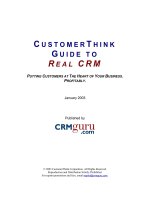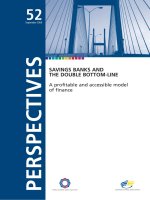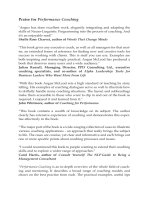Tom lydon the ETF trend following playbook prof
Bạn đang xem bản rút gọn của tài liệu. Xem và tải ngay bản đầy đủ của tài liệu tại đây (11.82 MB, 225 trang )
From the Library of Gayle M. Noll
The ETF Trend Following Playbook
From the Library of Gayle M. Noll
This page intentionally left blank
From the Library of Gayle M. Noll
The ETF Trend Following Playbook
PROFITING FROM TRENDS IN BULL OR BEAR
MARKETS WITH EXCHANGE TRADED FUNDS
TOM LYDON
From the Library of Gayle M. Noll
Vice President, Publisher: Tim Moore
Associate Publisher and Director
of Marketing: Amy Neidlinger
Executive Editor: Jim Boyd
ditorial Assistant: Myesha Graham
Operations Manager: Gina Kanouse
Senior Marketing Manager: Julie Phifer
Publicity Manager: Laura Czaja
Assistant Marketing Manager: Megan Colvin
Cover Designer: Alan Clements
Managing Editor: Kristy Hart
Project Editor: Anne Goebel
Copy Editor: Krista Hansing Editorial
Services, Inc.
Proofreader: Apostrophe Editing Services
Indexer: Lisa Stumpf
Compositor: Jake McFarland
Manufacturing Buyer: Dan Uhrig
© 2010 by Pearson Education, Inc.
Publishing as FT Press
Upper Saddle River, New Jersey 07458
This book is sold with the understanding that neither the author nor the publisher is engaged in rendering legal, accounting, or other professional services or
advice by publishing this book. Each individual situation is unique. Thus, if legal
or financial advice or other expert assistance is required in a specific situation,
the services of a competent professional should be sought to ensure that the situation has been evaluated carefully and appropriately. The author and the publisher disclaim any liability, loss, or risk resulting directly or indirectly, from the use
or application of any of the contents of this book.
FT Press offers excellent discounts on this book when ordered in quantity for bulk purchases or special sales. For more information, please contact U.S. Corporate and
Government Sales, 1-800-382-3419, For sales outside
the U.S., please contact International Sales at
Company and product names mentioned herein are the trademarks or registered trademarks of their respective owners.
All rights reserved. No part of this book may be reproduced, in any form or by any means,
without permission in writing from the publisher.
Printed in the United States of America
First Printing August 2009
ISBN-10: 0-13-702901-2
ISBN-13: 978-0-13-702901-3
Pearson Education LTD.
Pearson Education Australia PTY, Limited.
Pearson Education Singapore, Pte. Ltd.
Pearson Education North Asia, Ltd.
Pearson Education Canada, Ltd.
Pearson Educación de Mexico, S.A. de C.V.
Pearson Education—Japan
Pearson Education Malaysia, Pte. Ltd.
Library of Congress Cataloging-in-Publication Data
Lydon, Tom, 1960The ETF trend following playbook : profiting from trends in bull or bear markets with
exchange traded funds / Tom Lydon.
p. cm.
Includes bibliographical references.
ISBN-13: 978-0-13-702901-3 (hardback : alk. paper)
ISBN-10: 0-13-702901-2
1. Exchange traded funds. 2. Stock index futures. 3. Investments. I. Title.
HG6043.L928 2010
332.63'27--dc22
2009022712
From the Library of Gayle M. Noll
Thanks to Mom and Dad; my wife, Lisa Ann; our kids, Creagan,
Cameron, and Anya; and Lily, our dog, for their love and support
From the Library of Gayle M. Noll
This page intentionally left blank
From the Library of Gayle M. Noll
Table of Contents
Acknowledgments
. . . . . . . . . . . . . . . .xii
About the Author
. . . . . . . . . . . . . . . .xiv
Introduction: Buy–and–Hold: Rest in Peace . . .xv
Chapter 1
Trends Are an Investor’s Best Friend
. . . . . .1
Buy-and-Hold’s Funeral March . . . . . . . . . . .4
Getting in Touch with Your Emotions . . . . . . .7
Never-Ending Opportunities . . . . . . . . . . . .9
Chapter 2
Risk and Disaster Don’t Have to Go
Hand-in-Hand . . . . . . . . . . . . . . . . . .11
Greed and Fear and Stocks, Oh My! . . . . . . .12
Running Scared
. . . . . . . . . . . . . . . . . .13
What Kind of Risk Level Can You Tolerate? . . .14
Types of Risk . . . . . . . . . . . . . . . . . . . .16
Staying Grounded
. . . . . . . . . . . . . . . . .17
Is Time on Your Side? . . . . . . . . . . . . . . .17
The Go-Getter (Aggressive)
. . . . . . . . .17
The In-Betweener
(Somewhat Less Aggressive) . . . . . . . . .18
The Almost There
(Moderately Conservative) . . . . . . . . . .18
The I’m Outta Here (Conservative) . . . . .18
Chapter 3
Spotting Trends
Tools of the Trade
. . . . . . . . . . . . . . . . .23
. . . . . . . . . . . . . . . . .23
Learning to Identify Trends . . . . . . . . . . . .24
From the Library of Gayle M. Noll
THE ETF TREND FOLLOWING PLAYBOOK
The Rules of the Game
. . . . . . . . . . . . . .25
Understanding the Moving Average . . . . . . . .26
Exiting Safely and Profitably . . . . . . . . . . . .27
Avoiding a Bursting Bubble . . . . . . . . . . . .29
Learning to Live with “the Sell” . . . . . . . . . .29
Finding the Trends . . . . . . . . . . . . . . . . .30
Up, Down, and Flat as a Pancake . . . . . .31
Timing Is Everything
Chapter 4
. . . . . . . . . . . . . . .35
Why Trend Following Can’t Be Beat . . . . . .39
Never Look Back . . . . . . . . . . . . . . . . . .42
What Happens After You Sell?
. . . . . . . . . .43
Conquer Volatility, Don’t Let It Conquer You . .44
Do You Have Any Better Ideas?
. . . . . . . . .44
Buy-and-Hold: Does It Work Like It Should? . .45
Where That Leaves Us . . . . . . . . . . . . . . .46
Chapter 5
The Nuts and Bolts of ETFs
. . . . . . . . . .49
Why ETFs Are a Better Solution . . . . . . . . .50
A Fast-Growing Industry
. . . . . . . . . .53
Evaluating ETFs . . . . . . . . . . . . . . . . . .54
Employing ETFs . . . . . . . . . . . . . . . . . .56
Chapter 6
Tools You Can Use . . . . . . . . . . . . . . . .61
News
. . . . . . . . . . . . . . . . . . . . . . . .61
Analysis . . . . . . . . . . . . . . . . . . . . . . .62
Looking Under the Hood . . . . . . . . . . . . .63
Charting
. . . . . . . . . . . . . . . . . . . . . .64
viii
From the Library of Gayle M. Noll
CONTENTS
Chapter 7
Navigating U.S. Markets
. . . . . . . . . . . .65
Choices Galore . . . . . . . . . . . . . . . . . . .66
Dow Jones Industrial Average . . . . . . . .67
The S&P 500 . . . . . . . . . . . . . . . . .69
Russell Mid-Cap Index . . . . . . . . . . . .70
The Russell 2000 . . . . . . . . . . . . . . .70
Growth Versus Value . . . . . . . . . . . . . . . .72
Value: Slower but Steadier . . . . . . . . . . . . .72
Trends in Value and Growth . . . . . . . . . . . .73
Domestic Market ETFs . . . . . . . . . . . . . .74
Digging in Even Deeper . . . . . . . . . . . . . .75
Chapter 8
International Opportunities . . . . . . . . . . .77
The Land of the Rising Sun...and Profits . . . . .79
The Beginning of the End . . . . . . . . . . . . .80
Emerging Markets . . . . . . . . . . . . . . . . .82
China’s Dragon . . . . . . . . . . . . . . . .84
Investing in Emerging Economies . . . . . .86
Another BRIC in the Wall . . . . . . . . . .87
International ETFs . . . . . . . . . . . . . . . . .88
Developed Markets
. . . . . . . . . . . . . . . .89
Emerging Markets . . . . . . . . . . . . . . . . .90
Chapter 9
The Best-Looking Sector in the Room . . . . .93
Technology: High Highs and Lower Lows . . . .95
The Bubble Springs a Leak . . . . . . . . . . . .96
Passing Around Blame . . . . . . . . . . . . . . .98
One Big Financial Mess . . . . . . . . . . . . . .99
ix
From the Library of Gayle M. Noll
THE ETF TREND FOLLOWING PLAYBOOK
The Beginning of the Global Crisis
. . . . . . .100
Sector-Specific ETFs . . . . . . . . . . . . . . .101
Power Up with Utility ETFs . . . . . . . . . . .103
Checking Up on Healthcare ETFs . . . . . . . .104
Banking on Financials
. . . . . . . . . . . . . .104
Chapter 10 The Luster of Gold and Crude
. . . . . . . .107
Oil: A Slippery, Yet Profitable Slope . . . . . . .110
Turning Trends into Profits . . . . . . . . . . . .113
Owning Your Share of Commodities . . . . . . .114
Agriculture
. . . . . . . . . . . . . . . . . . . .116
Energy . . . . . . . . . . . . . . . . . . . . . . .117
Metals (Precious, Base, and Industrial) . . . . .118
Broad-Based Commodity ETFs . . . . . . . . .119
Going the Roundabout Way . . . . . . . . . . .120
South Africa . . . . . . . . . . . . . . . . .120
Chile . . . . . . . . . . . . . . . . . . . . .121
Russia . . . . . . . . . . . . . . . . . . . .121
Australia . . . . . . . . . . . . . . . . . . .121
Commodities: A Valuable Part of Your Portfolio 122
Chapter 11 The World of Currencies . . . . . . . . . . . .123
Monitoring the Ups and Downs of Money
A Rocky Road for the U.S. Dollar
. . .123
. . . . .124
Citizens Suffer . . . . . . . . . . . . . . . .124
The Dollar Bucks Its Trend—Will It Last? . . .126
Making the Most Out of Currency ETFs . . . .129
Squeezing the Most from Your Dollars
. . . . .131
x
From the Library of Gayle M. Noll
CONTENTS
Chapter 12 Trends in Fixed Income
. . . . . . . . . . . .133
Factors to Consider . . . . . . . . . . . . . . . .137
The Yield Curve
. . . . . . . . . . . . . . . . .139
Recent Trends Spotted . . . . . . . . . . . . . .141
Taxes and Municipal Bond Trends . . . . . . . .142
High-Yield Opportunity
Fixed-Income ETFs
. . . . . . . . . . . . .144
. . . . . . . . . . . . . . .144
Who Wants Bonds? . . . . . . . . . . . . . . . .146
How to Choose Bond ETFs . . . . . . . . . . .147
Chapter 13 Getting Leverage in the Markets
The Long and Short of ETFs
. . . . . . .149
. . . . . . . . . .150
Pumping Up Returns . . . . . . . . . . . . . . .154
Chapter 14 Conclusion: Let’s Get to Work . . . . . . . . .159
Switching from Mutual Funds to ETFs . . . . .161
Working with Your Advisor . . . . . . . . . . . .162
Wrap–Up
. . . . . . . . . . . . . . . . . . . . .164
Glossary . . . . . . . . . . . . . . . . . . . . .165
References and Resources . . . . . . . . . . .181
References
. . . . . . . . . . . . . . . . . . . .181
Resources . . . . . . . . . . . . . . . . . . . . .197
Books
Services
Index
. . . . . . . . . . . . . . . . . . . .197
. . . . . . . . . . . . . . . . . . .198
. . . . . . . . . . . . . . . . . . . . . .199
xi
From the Library of Gayle M. Noll
Acknowledgments
I’d like to thank the numerous people who generously gave us their
time and shared their thoughts about ETFs, including the many readers of ETFTrends.com and fellow investment advisors, whose ideas,
feedback, and opinions are what made this book possible. I’d especially like to thank the ETF Trends readers who shared their thoughts on
investing with us, including William Doherty, Bill Fritz, Hamish
Gunn, Bryant Hayward, Roger Hing, Rick Holbrook, and Ted
Spickler.
Thank you to all of our ETF industry friends, fellow bloggers, and
personal friends, including Larry Connell, Gary Gordon, Bob
Grayson, Ted Kennedy, Phil Pegram, Bob Pisani, and Peter Tolk.
Thanks to the team at Jennifer Connelly Public Relations: Jennifer
Connelly, Melinda Staab, and Carol Graumann. Thanks also to
Darlene March at March Media Relations.
Thanks to Werner Keller, Chip Norton, and Steven Vames for sharing
their valuable expertise and knowledge with us to make this a better,
more informative book for our readers.
Thank you to John Bishop, who shared his experience and thoughts
with us and gave an honest, page-by-page critique of the book.
Thank you to Max Chen, Kevin Grewal, and Tisha Guerrero for sharing their talent for writing and helping make ETF Trends a better web
site.
Thanks to all the ETF Trends advertisers who keep the site going and
growing.
I’d like to thank Jim Boyd, Anne Goebel, Kristy Hart, and Julie Phifer
xii
From the Library of Gayle M. Noll
ACKNOWLEDGMENTS
at FT Press for taking us on once again and guiding us.
Thanks to Virginia Zart and Melody Harris for their day-to-day support and for putting up with me.
A special thank you to Karen Riccio for leading this project. Another
special thank you to Heather Hayes for seeing this through to completion with the same care she used in our first book.
Finally, thanks to Mom and Dad and to my wife, Lisa Ann; our kids,
Creagan, Cameron, and Anya; and Lily (our dog), for their love and
support.
xiii
From the Library of Gayle M. Noll
About the Author
Tom Lydon is the proprietor of ETF Trends, a web site with daily
news and commentary about the fast-changing trends in the exchange
traded fund (ETF) industry. Mr. Lydon is also president of Global
Trends Investments, an investment advisory firm specializing in the
creation of customized portfolios for high-net-worth individuals. He
has been involved in money management for more than 25 years.
Mr. Lydon began his career with Fidelity Investments and was a
founding member of Charles Schwab’s Institutional Advisory Board.
He also serves on the board of directors for U.S. Global Investors,
Inc.; Security Global Investors/Rydex Investments; and the Pacific
Investment Management Co., LLC (PIMCO), Advisory Board for
Registered Investment Advisors. Mr. Lydon is a regular contributor to
major print, radio, and television media and has been invited to speak
to audiences at financial conferences around the world. Mr. Lydon is
the author of iMoney: Profitable Exchange-Traded Fund Strategies for
Every Investor.
xiv
From the Library of Gayle M. Noll
Introduction
BUY–AND–HOLD: REST IN PEACE
For decades, the vast majority of us have enjoyed opportunities to
improve our personal economic situations. Appreciation in our home,
a steady job, growing industry, and continual rises in the stock market
are sometimes taken for granted. But the things investors were once
able to bank upon are no longer there. Buying and holding stocks can
no longer be counted upon as sure things for success.
Our current century hasn’t started off so well, and you and millions of others are being forced to rethink your investment strategies
to survive. The markets certainly saw their fair share of volatility
before now, but this is different. Times have changed.
For much of modern investing history, you and countless other
investors have heard that buy-and-hold was the way to go. Experts
have assured us that, no matter what happens in the markets, they
always trend up over time. If you could just hang on and ride it out,
you would be duly rewarded with a handsome retirement fund.
But during the last half of the 2000s, you and millions of others
have lived through events rarely seen in history. The nation’s largest
financial institutions were felled by both a lack of accountability and a
lack of transparency. It was an economic crisis for the history books,
likely to be dissected and analyzed for years to come.
In the end, if you were among those who held on for dear life,
believing that buy-and-hold would prevail, you wound up losing big.
Your plans for a comfortable retirement are now dashed.
Accountability and transparency seem nonexistent. The net result is
that you and others have not only lost big bucks—you have probably
also lost faith.
xv
From the Library of Gayle M. Noll
THE ETF TREND FOLLOWING PLAYBOOK
What eventually became known as the United States’ “Lost
Decade” began well enough when markets hit highs in March 2000.
But it wasn’t meant to last. For the next few years, a large, unruly bear
came in and tore the house down. Technology and the bursting
Internet bubble led the big decline, ultimately taking down the
NASDAQ Composite (generally referred to as “the NASDAQ”
throughout this book) and S&P 500 by 75% and 45%, respectively.
A brief honeymoon lifted the markets from 2003 to 2006, giving
investors a reason to believe once again—but along came 2007 and
the kickoff of a new bear. This one was the bear of nightmares, some
might say. At the end of 2008, the NASDAQ closed down a dismal
41%. The S&P 500 fell 39%—and continued to lose into 2009.
There’s always a bogeyman in these markets, right? Savings and
loans, dotcoms, oil and gas. The new object of scorn in the markets
was real estate—strange and complicated bets, the revelation of a
slimy subprime mortgage business, and the ultimate dismantling of
some of the world’s largest banks and brokerages.
The old way of doing things is worth revisiting, now more than
ever. Boom-and-bust cycles are coming with greater frequency and
more intensity, eroding the “sure thing” status that buy-and-hold once
had. In fact, I’ll show you evidence that buy-and-hold hasn’t been
working anymore and what you can do about it.
I’ll give you several examples of market uptrends and downtrends
and how to identify them using the 200-day moving average. I’ll show
you how to apply this strategy to industry-specific markets and sectors
in the United States and abroad.
In the end, you will be confident and armed with an easy-tounderstand, nonemotional investment strategy that works in any
market climate. Up, down, sideways, and no-ways, you’ll walk away
with the tools you need to put trend following to work, to make money
and protect your assets with a disciplined investment strategy.
xvi
From the Library of Gayle M. Noll
INTRODUCTION
Now is the time to take a more active role in your portfolio by following the trends using a simple strategy that can help protect you on
the downside while having you in the markets for potential long-term
uptrends.
What can you gain from all this? You will have peace of mind. You
will know how to manage your emotions. You will know that you can
make money in any kind of market and avoid those bubbles, booms,
and busts that have plagued so many other investors.
What are you waiting for? Let’s get started!
xvii
From the Library of Gayle M. Noll
This page intentionally left blank
From the Library of Gayle M. Noll
chapter 1
Trends Are an Investor’s
Best Friend
Of all the things you can teach yourself to become a better investor,
the best thing is to learn how to identify trends. You probably do it
now, to a degree. Perhaps when you heard that oil was nearing $100 a
barrel in 2008, you noticed the uptrend. When you heard about bidding wars over houses, you noticed that real estate was trending higher, too. Although you might be familiar with what a bear market or a
bull market looks like, to spot trends, you’ll have to zoom in a little
closer.
Often by the time news of a trend spreads to the point where it’s
cocktail-party fodder, the bulk of the profits have been made. What
you need to do instead is learn to spot trends as early as possible in
order to enjoy the longest ride possible.
Figure 1.1 shows the long upswings the market has experienced,
followed by equally long corrections. In some cases, these corrections
have been devastating. For example, investors who bought in late
2002 would have realized nice gains until about 2007, when the bottom dropped out.
Had you who patiently waited as the S&P 500 climbed and
climbed, then hung on as it fell, you would have seen six years go
down the tubes.
Believe it or not, you don’t have to just sit there. Very few people
predicted either of these two bear markets, but investors could have
avoided much of the damage to their portfolios simply by following
the general market trends.
1
From the Library of Gayle M. Noll
THE ETF TREND FOLLOWING PLAYBOOK
1700
1500
1300
1100
900
700
500
Dec-97
Dec-98
Dec-99
Dec-00
Dec-01
Dec-02
Dec-03
Dec-04
Dec-05
Dec-06
Dec-07
Dec-08
© 2009 ETF Trends
Figure 1.1
S&P 500 Index from 1997 to 2008
There is a simple approach that has been used to identify trends
for decades. It involves a simple mathematical calculation that identifies general market trends. It’s a strategy I’ve used for my own clients
for many years. In Chapter 3, “Spotting Trends,” I will show you how
it works, what it means, and places you can go for the most current
information on trend lines. The concept is simple. Take a look at
Figure 1.2. Imagine if you were in the market when the S&P 500 rose
above its 200-day moving average, and you were out when it fell below
that mark. You could have avoided extended losses simply by being
out, and you could have profited by being in at the right times.
But don’t stop here. You can apply this trend following strategy
anywhere—to any time period, in any market, with any security type.
Go ahead and apply the same logic to the devastating technologydriven bear market of 2000–2002 in Figure 1.3.
2
From the Library of Gayle M. Noll
TRENDS ARE
AN INVESTOR’S
BEST FRIEND
1700
1500
1300
1100
900
700
Price
200 EMA
500
Dec-97
Dec-98
Dec-99
Dec-00
Dec-0 1
Dec-02
Dec-03
Dec-04
Dec-05
Dec-06
Dec-07
Dec-08
© 2009 ETF Trends
Figure 1.2 S&P 500 Index with 200-day moving average from 1997-2008
6000
5000
4000
3000
2000
1000
Price
200 EMA
0
Dec-97 Dec-98 Dec-99 Dec-00 Dec-01 Dec-02 Dec-03 Dec-04 Dec-05 Dec-06 Dec-07 Dec-08
© 2009 ETF Trends
Figure 1.3
NASDAQ Composite with 200-day moving average from 1997-2008
3
From the Library of Gayle M. Noll
THE ETF TREND FOLLOWING PLAYBOOK
If you are among the millions who bought technology stocks in
the 1990s, only to hold them through one of the most devastating bear
markets, you lost as much as 60%–70% in many cases and have still
not even come close to recouping that money. But just as damaging as
losing money is the loss of time.
Buy-and-Hold’s Funeral March
Some of you may be thinking, “What ever happened to the buy-andhold strategy? It has worked for me for 40 years.” Well, that may be
true, but take my word for it—and the word of many others: It won’t
work moving forward.
You might want to be sitting down for this: Buy-and-hold is dead.
(And there’s no Easter Bunny, either.) Wall Street’s mantra is losing
steam and support fast and furiously. Investment pioneers Benjamin
Graham, Warren Buffett, and Burton Malkiel spewed the virtues of
buy-and-hold for years, but the ugly truth is if you are among the
investors who have followed this strategy so far this century, you have
lost money.
In fact, Buffett reportedly lost more than $16 billion in 2008,
enough to make Graham squirm in his grave. While that figure doesn’t
represent the average investor’s losses, it shows just how disastrous
buy-and-hold can be.
The bottom line is, buy-and-hold simply hasn’t worked. If you’re
already in retirement or are planning retirement, you might be in a
terrible situation. The fact that you’ve lost money and that there’s
nothing you felt you could have done about it has had a drastically
negative effect on your future plans. You might have considered going
back to work part-time, or you might have had to call off retirement
for now. It’s an ugly scenario for someone to be in, and it’s even
uglier when you consider that many people could have avoided it
altogether.
4
From the Library of Gayle M. Noll
TRENDS ARE
AN INVESTOR’S
BEST FRIEND
The country is in the middle of a major influx of baby boomers
who are now moving into retirement, but many of them are finding
themselves in the uncomfortable position of having to put off what,
just five years ago, was a certainty.
For example, let’s say that you’re a buy-and-hold investor who had
planned on retiring in 2009. You’re turning 66, you know that you
have the money to do it, and you are ready. But then a crash comes.
Now you’ve lost 40% of your portfolio. Suddenly, retirement for you
seems as far away as childhood. And when will you have the time to
make up the money lost? The closer you are to retirement, the less
you can afford to hang on and ride both the ups and downs.
You can find evidence of this by looking at the wheel-spinning the
markets have been doing: Had you invested in the S&P 500 in 1997
and held on to it through all the ups and downs until early 2009 (and
maybe even later), you would be below where you started. All told,
that’s more than ten years of investing with little to show for it outside
of dividends. And what’s more, you’d be 12 years older. Those of you
who are planning for retirement or who are in retirement can tell the
rest of you about the pain.
“It’s time to unlearn a common myth about investing,” Jim
Cramer told viewers on CNBC in late 2008. “The best way to invest
is not to buy a bunch of stocks and just sit on them.” This doesn’t happen often, but I agree wholeheartedly with Cramer. Outside of raging
bull markets like the one we experienced in the 1990s, the strategy of
buying stocks and holding on to them for eternity no longer works.
During bear markets, you stand to lose a whole lot of money, and in
sideways markets, your assets will flatline.
But here’s the rub: The term sideways market is somewhat misleading. There’s plenty of market activity, but it’s in the form of a sharp
downward move, followed by a sharp upward move. Sideways markets
can wear on your emotions. They’re extremely frustrating and, most
important, they burn up a lot of time. Have you ever gotten stuck in
5
From the Library of Gayle M. Noll
THE ETF TREND FOLLOWING PLAYBOOK
the snow or mud? The sensation that your wheels are spinning wildly
as you dig a deeper and deeper hole is not unlike the feeling some get
in markets that are going nowhere fast.
There are a handful of periods in this century where the market
has made no money for ten years or more. For example, an investment in stocks that made up the S&P 500 Index during the periods of
1929–1942 (13 years), 1966–1982 (16 years), and 1997–2009
(12 years) would have amounted to no more than a break-even
investment.
From 1997 until 2009, the S&P 500 fell in value an average of
0.4% per year. Through the end of 2008, after two devastating market
collapses, the S&P 500 returned 7.1% since 1950 and 7.8% since
1980. In 2000–2008, the S&P’s performance was down a dismal 4.7%,
including dividends. You don’t have to retrace the past decade or
more to see the damage this outdated strategy can cause.
Listen: Life is short. All of us only have so much time to save for
our golden years. I don’t know about you, but I certainly don’t have
ten years’ worth of retirement savings to just up and lose—and then
slowly but surely make it up until I’m back where I was before, hoping that there’s not another bust before I’m sent back to the starting
line again. You and other investors simply cannot afford to suffer the
drastic losses we saw in the recent bear markets.
I had never quite heard the strategy of buy-and-hold put this way,
but I couldn’t agree more with Mike Macdonald, an investment portfolio consultant with Toronto-based Second Opinion Investor
Services:
“Buy-and-hold is a platitude that is outdated. Everything and
everybody needs to be monitored regularly because it is often
an investor’s life savings and future lifestyle that is at risk.
Buy-and-hold is like an airplane’s autopilot. It works great
6
From the Library of Gayle M. Noll









